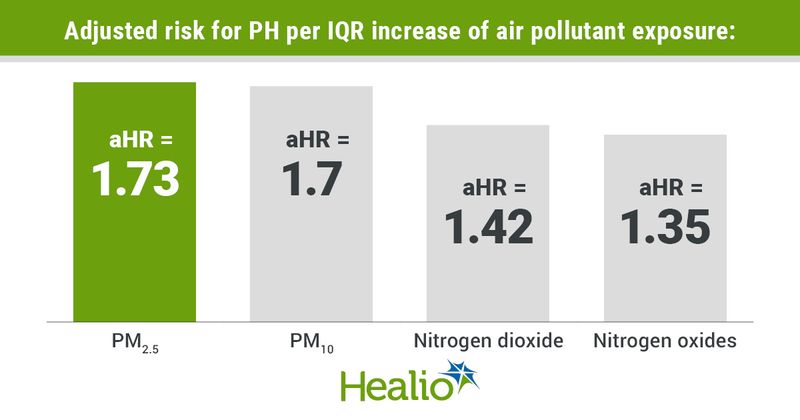Air pollutants linked to heightened risk for pulmonary hypertension, death
Key takeaways:
- Exposure to fine particulate matter raised the risk for a diagnosis of pulmonary hypertension.
- Previous/current smokers vs. never smokers faced greater risks for PH and death with air pollutant exposure.
Individuals exposed to some ambient air pollutants faced heightened risks for both diagnosis and death of pulmonary hypertension, according to results published in Ecotoxicology and Environmental Safety.
These included fine particulate matter of 2.5 µm or less (PM2.5) or 10 µm or less (PM10), nitrogen dioxide and nitrogen oxides.

“The results of the present study demonstrated that exposure to ambient air pollutants played a significant role in the progression of [pulmonary hypertension], with a greater impact on the incidence of PH than mortality,” Hui Shi, of the department of epidemiology in the School of Public Health at Sun Yat-sen University in China, and colleagues wrote. “PM2.5 and PM10 were stronger associated with the incidence of PH and subsequent death compared to other pollutants.”
In a multistate trajectory analysis, Shi and colleagues evaluated 494,750 individuals (mean age, 56.5 years; 54.6% women) from the UK Biobank study to determine how exposure to nitrogen dioxide, nitrogen oxides, PM2.5 and PM10 are linked to PH incidence and death through multivariate multistate models.
Researchers used mean annual concentration data from the UK Department for Environment, Food and Rural Affairs on the various pollutants and individuals’ home addresses to estimate their level of exposure.
Of the total cohort, 2,517 individuals had a diagnosis of incident PH over median follow-up of 11.75 years, 696 of whom died.
When assessing air pollution exposure in relation to PH incidence, researchers found elevated risks with all studied pollutants following adjustment for age, sex, ethnicity, BMI, household income, education level, smoking status, associated conditions and noise. The pollutants with the highest hazard ratios per interquartile range (IQR) increase included PM2.5 (adjusted HR =1.73; 95% CI, 1.65-1.81) and PM10 (aHR = 1.7; 95% CI, 1.63-1.78), followed by nitrogen dioxide (aHR = 1.42; 95% CI, 1.37-1.48) and nitrogen oxides (aHR = 1.35; 95% CI, 1.31-1.4).
The risk for PH mortality also appeared impacted by all studied pollutants. Researchers again found the highest hazard ratios with exposure to PM2.5 (HR =1.35; 95% CI, 1.25-1.45) and PM10 (HR = 1.31; 95% CI, 1.21-1.41), but nitrogen dioxide (HR = 1.28; 95% CI, 1.2-1.37) and nitrogen oxides (HR = 1.24; 95% CI, 1.17-1.32) followed closely behind.
During an additional analysis that separated previous (34.3%) and current smokers (10.5%) from never smokers (54.6%), researchers found that individuals who previously or currently smoked had stronger associations for PH with exposure to PM2.5 (HR = 1.75; 95% CI, 1.61-1.9), PM10 (HR = 1.72; 95% CI, 1.59-1.86), nitrogen dioxide (HR = 1.46; 95% CI, 1.37-1.56) and nitrogen oxides (HR = 1.39; 95% CI, 1.31-1.48).
Previous or current smokers also faced stronger risk for death with PH when exposed to either type of particulate matter (PM2.5: HR = 1.45; 95% CI, 1.3-1.63; PM10: HR = 1.41; 95% CI, 1.26-1.58).
Further, when considering individual demographics (sex, education, age, income), researchers found that men faced a higher risk for PH than women with nitrogen dioxide exposure. Additionally, an increased risk for PH with exposure to each of the four pollutants was found among individuals with a low vs. high level of education.
“These findings significantly enhance our understanding of the potential effects of air pollution on the pulmonary vasculature, providing valuable new data for evaluating the long-term effect of air pollution exposure on PH,” Shi and colleagues wrote. “Furthermore, formulating policies that aim to improve air quality and reduce exposure to air pollution is crucial, especially for individuals who are highly susceptible.”
